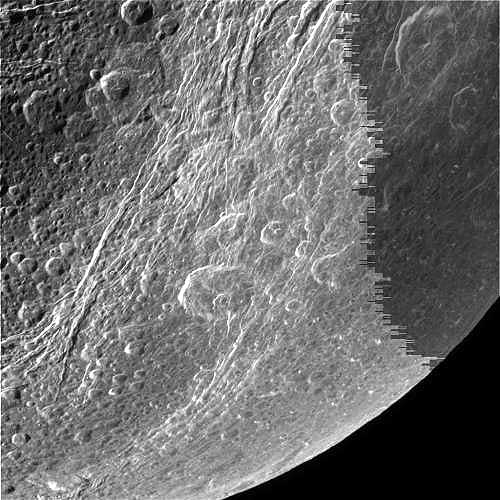About a week ago we promised a Cassini pass by the moon Dion, and here we are * in a year - approaching to a distance of 500 kilometers from the surface of Dion

Just a few days after the second flyby of Titan, Cassini continued to its next destination - Dione, the fourth largest moon. The moon came within 81 kilometers of Dion's face and released a stream of close-up images of its strange surface that are now being analyzed by scientists.
Dion is a relatively small moon, only 560 kilometers in diameter and it orbits Saturn once every 2.73 days, which is roughly the time it takes for it to orbit its axis. The moon is 377,400 kilometers from its parent planet. Dion is also known to share an orbit with a small asteroid known as Helene that managed to settle into a stable point in orbit. The temperature on the surface of Dion is similar to that of Titan - 186 degrees Celsius below zero, and cryogenic activity on its surface is responsible for shaping the surface of the moon, although unlike Titan, Dion does not have an atmosphere.
Cassini's pass this week helped confirm the theory that sometime in the Moon's past it experienced two periods of cryo-volcanic flow that affected different areas of its surface. The scientists believe that these episodes originate from tidal heating caused by the approach to another moon of Saturn - Enceladus.
When the Cassini spacecraft approached the moon Dion this week, it took pictures of an unmapped area known as the trailing hemisphere, centered at zero latitude and 270 longitude dominated by three craters, the largest of which is called Amata and two smaller craters Catillus and Coras. Geologically, this is one of the most interesting areas on the Moon for planetary astronomers because this area of discussion is marked by two distinguishable sets of rays.
The large system called the Palatine Linea crosses the moon towards the south pole area and ends in a large crater that has not yet been named. The new images taken by Cassini show the area as consisting of long, straight groves of mountains and other formations, occasionally alternating with small craters and furrows at varying distances.
The second white linear formation, called the Padua Linea, is about half as long as the Palatine, and it is also divided by straight furrows that stretch from the equator at longitude 240 degrees down toward the southeast and end at latitude minus 20 degrees. The large crater that dominates this area is called Cassandra and is prominent in the images taken by Cassini.
Cassini also imaged the leading hemisphere for the first time between longitudes 145-180 degrees at about 40 degrees latitude on either side of the equator, and this side also appears to be dotted with small impact craters.
All eight images taken by Cassini on December 15th show that Dion is dotted with many small craters and among them are several large craters at large distances from each other, all unmapped and unnamed. Moreover, Cassini confirmed what planetary scientists had believed all along, that the reshaping of Dion's surface must have occurred long before Enceladus' surface change, because the less cratered areas of Dion are dotted with far more craters than those on Enceladus.
While Dion's images are the best and shortest-range images of the moon, the Cassini spacecraft is scheduled for another flyby, much closer to Dion in October 2005, when it will pass just 500 kilometers above the lunar surface.
Saturn's moon Dione is visible from Earth at +10.4 magnitude, and is therefore visible in medium and higher telescopes.
